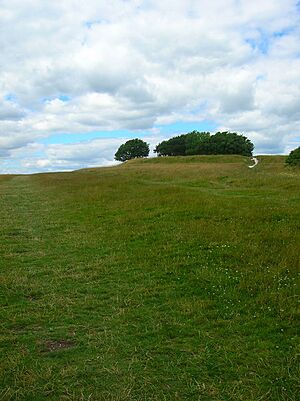Highdown Hill facts for kids
Highdown Hill is a well-known hill in the South Downs area of England. It stands about 81 meters (266 feet) tall. The top and western side of the hill are in Ferring, while the eastern side is in Worthing.
Highdown Hill is a popular place for families to have picnics, for people to walk their dogs, and for horse riders. From the hill, you can see Littlehampton, Angmering, Ferring, and Worthing. On clear days, you can even see the Seven Sisters cliffs to the east and the Isle of Wight to the west! The National Trust owns Highdown Hill. To the north, you can spot other ancient hill forts like Cissbury Ring and Chanctonbury Ring. There are also remains of an old hill fort right on top of Highdown Hill. Long ago, it was believed to be the burial place for the kings of Sussex.
At the bottom of the hill, there's a car park, toilets, and the famous Highdown Gardens. There's also a cafe, hotel, and restaurant nearby. The gardens are currently being updated with a big project.
Contents
Early History of Highdown Hill
People first started living on Highdown Hill a very long time ago, around 1000 BC, during the Late Bronze Age. They built a special enclosed area there. By the Early Iron Age, around 600 BC, this had changed into a hill fort. A hill fort was a strong, protected settlement with a single wall and a ditch around it.
Later, around 450 AD, an Anglo-Saxon cemetery was made on the hill. A cemetery is a place where people are buried. When this cemetery was found in the 1890s, it had many unusual glass objects. You can see some of these items today at the Worthing Museum.
The cemetery was discovered by accident when a local landowner named Edwin Henty was planting trees. Sadly, many items were lost or taken before archaeologists could properly dig and study the site.
Digging Up the Past
Archaeologists continued to dig at Highdown Hill for two more years. Charles Hercules Read, who was important in the Society of Antiquaries, helped guide the work. Between 1893 and 1894, they found 86 Anglo-Saxon graves. They carefully listed what was in each grave, and some were even drawn. However, a full map of the cemetery was never made.
At that time, some skeletons were left in their graves, while others were dug up. This meant that many bones and old objects were moved to different local museums. Unfortunately, many of these items have since been lost.
Highdown Hill in the 1700s
In the 1700s, a miller named John Olliver built his own tomb on Highdown Hill. He did this 27 years before he passed away in 1793! People say that John Olliver was actually the leader of local smugglers. Smugglers were people who secretly moved goods to avoid paying taxes. It's believed he used his tomb to hide these secret goods.
John Olliver would also set the sails of his windmill in different ways. This was a secret signal to his friends out at sea, letting them know if tax collectors were around or not. You can still see the remains of his old windmill on the west side of the hill.
The Legend of Roundstone
There's a local story that a runaway millstone from John Olliver's windmill rolled down the hill. This rolling stone is said to be why the farm at the bottom of the hill is called "Roundstone." Later, a nearby pub and a large garden centre also took on the name "Roundstone."
Highdown Hill in the 1900s
During World War II, a radar station was built on Highdown Hill. Building this station caused a lot of damage to the old archaeological sites on the hill. More damage happened when many trees were pulled up during the Great Storm of 1987. Because of this, archaeologists had to do a special "rescue dig" in 1988 to save what they could.
Highdown Hill Today
Today, the beautiful Highdown Gardens are located in an old chalk pit below the hill. There's also Highdown Vineyard, which is a working vineyard on the southern side of the hill. They make English wines there.
The name Roundstone is still used for a farm, a pub, and several other businesses near Highdown Hill. As the local legend says, this name comes from a millstone that supposedly rolled down from the old windmill on the hill.


